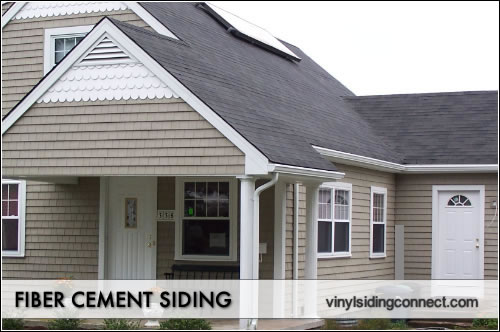Fiber cement siding is an excellent choice for homeowners who want the beauty of wood on the exterior of their homes, without the high costs and extensive maintenance requirements. It offers the look of traditional wood, but is virtually maintenance free and long lasting. Hiring a knowledgable contractor is important however as there can be issues with the boards warping if moisture gets in.

Fiber Cement Siding Basics
Fiber cement contains a mixture of cement, sand and fibers made up of cellulose filaments. During production, the mixture is treated with pressurized steam, making it a more durable and crack-resistant product. The original make-up contained asbestos, but due to the known harmful effects of asbestos, the cellulose filament has taken the place of asbestos in the mixture.


History
The product was invented in France over 100 years ago and is still a popular exterior siding option today around the world. This is due to the fact that fiber cement looks as good as wood but it’s easy to care for and is durable. In fact, many companies offer warranties for as long as 50 years. Although it is not as popular as vinyl siding these days and had gotten a bad rap for awhile due to the inclusion of asbestos in the material (which newer siding no longer has), it still accounts for nearly 10% of all siding installed today.

Fiber Cement Siding Cost
Entry To Mid Level: $3.50 – $5.25 psf
This equates to $350 to $525 per square installed.
Mid To High End Pricing: $5.25 – $7.00 psf
This equates to $525 to $700 per square installed. More on fiber cement siding cost
Also See Hardie Board Costs

Advantages
Extremely Strong
There are numerous benefits to choosing this cladding. It doesn’t rot, holds up well to all types of weather and temperature extremes, doesn’t warp or twist, resists fading, can handle high impact (such as wind and other harsh weather conditions), can withstand constant exposure to UV rays or salt spray (good for homes situated near the ocean), is fire resistant (good for homes situated near potential wildfires), impervious to insects and birds, crack resistant, long lasting and low maintenance. It also offers the good looks of wood without the high price tag or tedious maintenance requirements.

Ideal Climates And Locales
Fiber cement siding can be installed in just about any type of climate. It is an attractive option, however, in locales that have high humidity or a great deal of rainfall, since the material is impervious to the ill effects from water, moisture and mold. It is also a good option in hot, dry climates that are subject to wildfires, since it is fireproof. Due to the fact that the material can mimic the look of natural wood without the high maintenance required by wood (especially in these types of environments), it is a much better option in very wet or hot and dry climates.

Installation
For the most part, this siding is installed just like wood siding. It comes in 12 ft long planks that are usually 6 – 12 inches wide. It is installed directly over studs using surface nails, although blind nails can also be used (as long as the sections being installed aren’t too wide). Trim pieces used with fiber cement like Hardie Board should be made from vinyl rather than aluminum, since aluminum can corrode over time when exposed to fiber cement, due to the alkaline content of the material.

Cutting Boards
Fiber cement siding can be cut in much the same way as vinyl or wood cladding, although it is best to use specific types of cutting blades for this purpose (this will reduce the amount of dust created when cutting through the material). It is best to wear a mask to limit exposure to dust when cutting fiber cement siding, since breathing the dust in is not recommended. Care should also be taken when carrying and installing the fiber cement boards, since they are heavy and can crack, break or chip.

Colors And Finishes
Fiber cement siding comes in many aesthetic options. You can choose varying widths and lengths, finishes and colors. Finishes include embossed wood grain, stucco-like finishes, colonial rough-sawn or smooth finishes. There is also a wide selection of color choices available and some companies will offer custom color matching. It is best to opt for fiber cement siding that is factory painted, since the color coating is durable and can last as much as 25 years or more. If you paint it yourself, you may have to repaint every 4 – 5 years.



